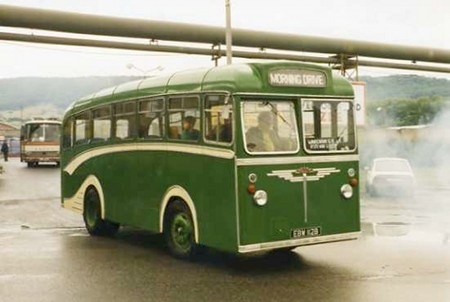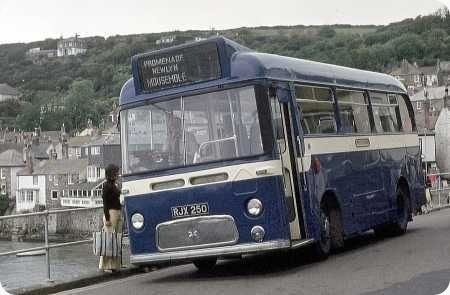Guernsey Railways – Albion Nimbus – 14626 – 72
Guernsey Railways Co Ltd
1964
Albion Nimbus NS3AN
Reading B35F
Here is a view of an Albion Nimbus, registration 14626. She is in the green and cream livery of the Guernsey Railways fleet and has a Reading body, with fleet number 72. The Guernsey Motors vehicles were a dark red (quite near the Northern General or Ribble "cherry") while Guernsey Railways vehicles were in this green and cream. She’s at Le Gouffre during a refreshment stop on a morning drive. At least, my ticket was for a morning drive, but the blind is set at Island Tour. Given the size of the island, I’ve never discovered the difference! Did the afternoon drive have a different route? The date is 15 September 1972.
Photograph and Copy contributed by Pete Davies
———
15/09/12 – 07:26
Here is its twin number 173 (14651) at the centenary rally in Usti-nad-Labem on 19/06/1999.
It had travelled from Wareham to the Czech Republic under its own power.
It was even blinded for the "Morning Drive".
What a superb event it was, we attended on ex North Western Road Car 413 (JMA 413L) a Bristol RE/ECW.
Dave Farrier
———
15/09/12 – 08:43
Am I being unrealistically demanding in thinking I’d have expected something a little more fancy than a stage carriage Albion Numbus for a scenic trip?
Roy Burke
———
16/09/12 – 07:19
No Roy. I would have baulked at the regular use, by Ribble, NWRRC (and friends) of service buses on their X2/X60 type services. I had a very enjoyable ride around the Isle of Wight last month on a B10M coach – and also later on open-topped Olympians! SUT, Yorkshire Services and the local indies always gave us coaches in Sheffield.
David Oldfield
———
16/09/12 – 07:20
So, MORNING DRIVE did exist on the blind, then? I suppose setting it for ISLAND TOUR covered most eventualities!!! I see that Dave’s note was posted 40 years to the day since I captured the scene.
Yes, Roy, most folk would expect something a little more grand for a tour, but I don’t recall seeing anything like that. This, after all, is somewhat more upmarket than the Albion CX or Bedford types elsewhere in the Guernsey fleets at that time.
Pete Davies
———
17/09/12 – 07:08
Until the advent of second hand Bristol SUs and LH in the eighties these were the last passenger chassis bought by Guernsey most of the Bedfords being based on lorry derived chassis The older Albion CXs had high backed coach type seats
Chris Hough
———
17/09/12 – 07:09
In response to Roy and David’s comments: Guernsey is quite small and distances short; and traffic very thin – I assume that economics dictated, and geography allowed, the use of buses on tour duties. Could Guernsey Railways/Motors have justified the purchase of special narrow-bodied coaches – and wasn’t the Guernsey width limit 7’4"? – which would have "laid up" out of season?. Its quite a different proposition to the use of buses for coaches on the mainland. Anyway, perhaps this was the Nimbus’s finest moment: tootling around impossibly narrow lanes, providing a "big bus" service where only truck-derived Bedfords followed . . . (until the Trafalger years).
Philip Rushworth
15/02/13 – 05:59
Not sure why people are referring to Albion ‘CX’ vehicles when they never operated on Guernsey. If they are referring to Victors (FT and earlier PH models), from 1950 the bodywork they carried (which was developed by Heaver and Guernsey Railways), was effective classed as ‘Service Coach’ standard, to be used on both stage carriage and island tours, etc. We would today classify this as Dual Purpose.
The Abion Victors (the chassis of which was also sold as the FT3 truck range) were followed by the Nimbus model, the style of body being adapted by Readings of Portsmouth), which was an underfloor engined Albion Claymore lorry chassis marketed under a different name for PSV use.
Guernsey’s final ‘standard’ vehicle to use this style of curved waistrail ‘Service Coach’ bodywork was the J4EZ1 model, which was derived from the Bedford truck range but popular for PSV and coach use between the OB going out of production and the VAS being developed.
Guernsey’s buses were no less inferior for their use of HGV derived chassis, nor were the many hundreds of Bedford J2 coaches used throughout the UK in the 60’s and 70’s. Of course the VAS chassis, designed for bus and coach use also ended up carrying truck bodies such as mobile library’s, etc. From an engineering point of view rural bus chassis and truck chassis were all but identical from the turn of the 20th century right up to the end of the 60’s, essentially being the same 3, 4 or 5 ton models, marketed under different names.
John
28/05/13 – 17:07
Contrary to misconception, all of Guernsey’s Albion Victors, Nimbus and Bedford J4 vehicles (delivered between 1950 and 1972), carried Service Coach bodywork for dual-purpose (stage carriage and tours) operation.
Their seating was identical throughout the classes being of the double-arched semi-high backed variety, well upholstered, though the moquette was updated over the years.
As far as the chassis were concerned, as John has pointed out above, the Albion Victor was derived from the FT3 truck series, the Nimbus was evolved from the Claymore underfloor-engined lorry and the J4EZ1 was Bedford’s long wheelbase 5-ton bonneted truck converted to forward control at the coach-builders under supervision from the local Bedford Agents.
In essence vehicle manufacturers frequently used engines, gearboxes, axles, cross members, braking and control systems, etc in common across their PSV and HGV ranges, only the chassis side frames for the former were specifically designed to ease the fitting of passenger bodywork, often being cranked over the axles to reduce step-heights. However, in terms of ride quality, comfort or reliability there was absolutely no appreciable difference between PSV or HGV chassis.
The width restrictions in Guernsey necessitated some diverse thinking with regards to chassis supply, often it was the axles that were over-width so it was more convenient, expedient and commercially acceptable to receive off-the-peg width-conforming 5-ton chassis rather than have a full blown PSV types converted to suit, which would have been a costly and often time-consuming exercise, where large volume manufacturers would need to take standard chassis off-line and effect bespoke modifications.
In pre-war days the maximum lawful vehicle width was restricted to 6′-6", this was changed to 7′-0" in 1945, then relaxed to 7′-4" after the last J4EZ5 / Pennine vehicles arrived in 1974. Due to restricted model availability, this was further relaxed to 7′-6" (for certain routes only)in 1979.
The 7′-4" vehicles that remained in the fleet after 1979 had their fleet numbers amended with an ‘A’ indicating they could serve ‘A’nywhere on the island’s route network.
The 7′-0" wide vehicles also received the ‘A’ suffix at the same time.
J Edward Rose
18/05/15 – 06:54
I have the privilege of owning Guernsey Railways 77 and have in the past owned several FT39 Albion Victors.
As has been previously mentioned the vehicle chassis is in principal Albion Chieftain FT37. On one occasion I purchased a life expired Chieftain for spares, the only difference I came across (to my cost) was that the truck road springs are shorter than the PSV springs, I assume to give the passengers a softer ride.
77 has now been in preservation for 35 years her operational life was just 23 years! whilst in preservation 77 has been "On the road" for at least 30 of the 35 years.
A good testament to Readings the body builder, Albion and her post Guernsey Railways owners.
Peter Davies
19/05/15 – 06:05
Well said, Peter, in your comments about Readings, Albion and 77’s owners in preservation. It makes one wonder how many Enviro 400s will still be around in 35 years time.
Incidentally, where I used to work, there were five of us named Peter Davies or Davis. We identified ourselves by using the Welsh system of ‘Davies the . . .’ The silly thing was that the one with the English spelling (no E for the uninitiated) was Welsh [Davis the Welfare, as he was in Social Services] and the four with the Welsh spelling were English, at least by birth although my grandfather WAS a Welshman! We were continually receiving each others post, and used to meet several times a week to exchange papers. No such troubles in your workplace, I hope!
Pete Davies
25/04/16 – 06:39
Guernsey Nimbus 75 16216, now carrying a UK reg JNP 590C, is also preserved and was out yesterday on the Cheshire Run, part of Drive it Day 2016.
Photo can be seen at www.oldclassiccar.co.uk/
John Lomas
30/04/17 – 07:50
And 175 will be out on the Cheshire Run again today.
Tim Smith
Quick links to the - Comments Page - Contact Page - Home Page






